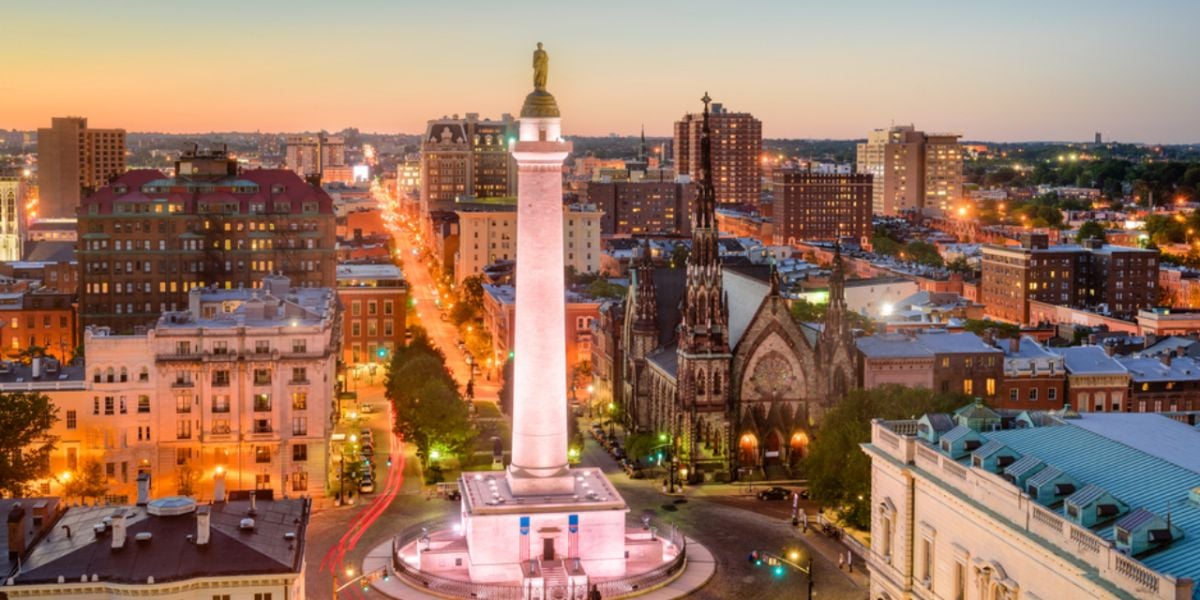
Baltimore may not be as famous as neighboring Washington, New York, and Philadelphia; however, it provides many benefits for international students looking to study in the US. If you avoid certain expensive areas, you'll experience a lower cost of living than in other large cities. Baltimore sits right on the water, and you'll have easy access to the beautiful rivers and inlets that make up Chesapeake Bay. So if you're looking to study in Baltimore, this article tells you everything about the higher education scene, the enrolment conditions for international students and student life.
Universities and programs for international students in Baltimore
On its own, Maryland hosts around thirty universities, including Johns Hopkins University, which is probably the most prestigious in Baltimore. In fact, Johns Hopkins University is one of the world's best universities. You could also opt for the University of Maryland, which boasts international students from over 150 countries.
Johns Hopkins University
Established in 1876, Johns Hopkins University has a deserved reputation as one of the pioneering research institutions in the United States. Over the years, it has maintained its position as a leading force in scientific research, earning the distinguished rank of the 15th best university globally in the Times Higher Education 2025 rankings and #32 in the QS World University Rankings 2025. In the 2025 edition of the U.S. News & World Report Best Colleges rankings, Johns Hopkins University achieved its highest-ever position, tying for 6th place among national universities.
With an admission rate of 7.5%, Johns Hopkins is highly selective in choosing its students – nonetheless it is home to over 5,500 international students and it has a well-deserved reputation for being a diverse campus. Popular programs for international students include Public Health, Medicine, Engineering, Data Science, Computer Science, International Business, Psychology, Life Sciences, Education, and Law. JHU offers various scholarships specifically for international students, including the Tan and Chen Global Education Scholarship, HEST, Education Future International Scholarship, as well as need-based and merit-based scholarships.
Annual tuition fees for international undergraduates are about USD 60,480.
University of Maryland, Baltimore County
The University of Maryland, Baltimore County (UMBC) is a public university founded in 1966. While it's not as famous as Hopkins, UMBC is ranked 771–780 in the QS World University Rankings and comes in at 137 in the USA by US News & World Report. The acceptance rate is currently 72.43%.
Since UMBC is a public university, tuition fees are more affordable than most private universities, making it an excellent choice for students on a limited budget. UMBC is developing a reputation for STEM excellence, fostering cutting-edge research and innovation across various disciplines. The university prides itself on its inclusive and diverse community, with the famous Meyerhoff Scholars Program well-known for its success in supporting underrepresented students in STEM fields. International student enrollment for undergraduates is currently around 2,300.
Out-of-state tuition is USD 28,000 per year.
Other Baltimore universities
- Morgan State University is a historically black university renowned for its strong emphasis on education, research, and community engagement.
- The University of Baltimore is known for its focus on professional education and applied learning. It offers various undergraduate and graduate programs in business, law, public affairs, and the arts.
- Loyola University Maryland is a Jesuit Catholic institution known for its strong liberal arts education and commitment to social justice. The university emphasizes critical thinking, ethical leadership, and community service.
Enrolment fees and scholarships in Baltimore
While the US can boast about having some of the world's most prestigious universities, the higher education system is quite costly compared to many European countries. For example, you should expect to pay at least USD 60,480 per year in tuition fees at Johns Hopkins University (2025). Public universities, however, are generally more affordable. State universities generally have two fee tiers: lower fees for local residents and higher fees for those from out of state. At UMBC, for example, you will need an average of USD 28,000 for out-of-state tuition.
There are scholarships available that can help with tuition costs. Students are eligible for scholarships regardless of their background,with scholarships largely based on academic records. High-performing students who do not have the means to finance their studies can apply for social scholarships, while students with the best grades are eligible for merit scholarships regardless of their family income. Note that these scholarships are subject to a quota that usually varies from one university to another. If you intend to apply for scholarships, check that the university you have chosen provides them and that international students are eligible for them.
Johns Hopkins University provides scholarships to international students on both a needs and merit basis. At UMBC, international students cannot apply for needs-based scholarships; however, other scholarships are available. International students can also pay their tuition fees via the Monthly Payment Plan, so they don't have to pay the total amount at once for the whole semester.
Academic calendar and courses in Baltimore
Courses are quite similar to those in most US and European universities and are either taught in small groups in a classroom or in an amphitheater with dozens of students. You can also participate in seminars where students are more involved in discussion and share their views and opinions. Exams can take the form of classwork or homework.
However, the academic calendar can take two different forms. The quarterly model goes from September to June and divides a school year into four semesters with an average of ten weeks each. The semester model divides a year into two parts, each with fourteen to twenty weeks, and is more common in the USA. At Hopkins, for example, the first semester starts on August 31st. However, dates can vary from one university or department to another.
Types of diplomas in US universities
The US rating system might appear complex initially, especially for those accustomed to the systems used in many European countries. In the US, teachers assign grades in percentage form, which are then converted to letters ranging from A to F. The Grade Point Average (GPA) serves as the official rating system in the US. Your homework and academic performance will be evaluated on a scale from A to F, where A represents the highest achievement with 4.33 points, and F indicates the lowest performance with 0 points.
Higher education in the US is structured into three levels: undergraduate, graduate, and postgraduate studies. The undergraduate level leads to a Bachelor's degree, typically requiring four years of study. Following that, graduate studies lead to a Master's Degree, which generally involves six years of academic pursuit. Lastly, postgraduate studies lead to a Doctorate or PhD.
If you are considering pursuing education in the US, make sure to verify whether your home country has established agreements with the US regarding the recognition and equivalence of diplomas and degrees. This can help ensure that your academic achievements are properly acknowledged and valued in both countries.
Student visas and admission criteria in Baltimore
Information regarding student visas for the USA will be available on the website of the US Embassy in your home country. If you are not a US citizen, you will definitely need a visa if you're looking to study in Baltimore. Most students apply for the F1 visa, which is delivered to full-time undergraduate, graduate, and postgraduate students. Those opting for technical or vocational studies, including hotels and hospitality, automotive, information and communication technology, and gastronomy, can apply for an M1 visa. However, this visa is only valid for one year and is renewable three times. The J1 visa is issued to international students participating in an exchange program and can be applied for when there is an agreement between a home-country university and a US university.
Not all student visa applications are fully online. Applicants must complete the DS-160 form online and upload all required documents at least 72 hours before their consular interview. The barcode on the DS-160 must match the appointment registration. Student visa applicants are now also required to provide two years of travel history and five years of social media account information. This new vetting process may cause significant delays in visa issuing for new students, so try and start your application as soon as you receive your admission letter. One positive development is that the SAT/ACT test is now optional at many universities, but remember to check each school's requirements. Health insurance remains compulsory for all students.
If required, you can find more information on how to prepare for the SAT and take part in the official exam on the College Board website. Graduate programs may also require you to have sat the GRE .
US universities also often require applicants to describe themselves and their motivations through a personal essay, which has to be submitted at the same time as the application. If this is an unfamiliar concept, there are lots of how-to guides online about how to write and format these essays.
How to enroll in a university in Baltimore
Contact your target university's International Office to learn more about legal administrative procedures regarding enrolment. Universities like Johns Hopkins and UMBC provide an exclusive portal to international students. Note, however, that admission fees are your responsibility. As an international student, you will also need to cover an average of USD 300 - USD 500 in visa fees, depending on your situation.
As mentioned above, it is compulsory for all students to have subscribed to health insurance before enrolment since the US health system is quite costly. Universities also offer their insurance scheme to students, but it remains expensive even though it's cheaper than private health insurance. Some universities accept international insurance and private US insurance, while others don't. At UMBC, for example, all students must subscribe to the university insurance scheme.
Study and work in Baltimore
Many students choose to work part-time during their studies in the US. As an international student, however, you must comply with specific conditions depending on your visa. F1 and J1 visa holders, for example, are allowed to work for a maximum of 20 hours per week and a maximum of 40 hours a week during vacation.
Students having an F1 visa are allowed to work off-campus from their second year under specific conditions. Off-campus work must be authorized as Curricular Practical Training (CPT), Optional Practical Training (OPT), or, in cases of severe economic hardship, and you must receive approval from your Designated School Official (DSO) and, in some cases, USCIS before starting any off-campus employment. In all situations, your university has to provide you with an authorization letter, with which you can obtain a Social Security number. You can only apply for a Social Security Number after receiving work authorization and a job offer. Note that the Social Security number is compulsory for working in the US, even if you have a student visa.
M1 visa holders are not allowed to work on or off campus. However, after completing their studies, they may engage in practical training for up to 6 months, provided they have received prior authorization from both their DSO and USCIS. Unauthorized work can result in immediate termination of your visa status and removal from the United States, so any breach of these rules should be avoided!
Student cost of living in Baltimore
The cost of living in Baltimore is slightly lower compared to other major cities on the East Coast. Accommodation will probably be one of your most significant expenses. The average rent for a one-bedroom apartment in Baltimore is USD 1,538 per month, with studios at USD 1,345 and two-bedrooms at USD 1,716. In popular neighborhoods like Fells Point or Inner Harbor, rents can exceed USD 2,000–USD 2,500. The average cost of living for a student, including rent, utilities, food, transportation, and essentials, is now about USD 2,100–USD 2,350 per month. Utilities (electricity, water, etc.) average USD 175–USD 450 per month.
To cut down on costs, flat-sharing is quite common as it's quite easy to find two-bedroom apartments. Also, remember that restaurant and coffee shop bills do not include tips. As a result, you must leave an additional 20% of the bill as a tip. Moreover, shop and supermarket prices do not include taxes, so be careful when doing your shopping. You might have to pay a few dollars more than expected.
Transportation won't be a significant expense for students in Baltimo,re as the city has an extensive transportation network, so you might not even need a car. In any case, it is not recommended to walk around the city's outskirts. Since Baltimorhasts a single subway line, most people prefer the Charm City Circulator, which connects the different neighborhoods with its five lines, free of charge.
Cultural institutions, including cinemas, museums, and art galleries, offer reduced rates to students holding student cards. The same applies to some shops and restaurants. Find a comprehensive list of student benefits and preferential rates in Baltimore on the StudentRate website.
Where to live when studying in Baltimore
As an international student in Baltimore, there are several options for accommodation. Many universities and colleges in Baltimore offer on-campus housing, providing a convenient and immersive living experience within close proximity to your classes and campus facilities. When applying as an international student, you will usually have an adviser or an international student center that can assist you with registering for university-based accommodation or offer suggestions about off-campus options.
Off-campus options include boarding, apartments, or shared housing. Areas like Charles Village, Mount Vernon, and Federal Hill are popular among students. Student areas can be competitive because of their easy commute to campus and student-friendly dining options, shops, and other amenities.
Living like a local in Baltimore
Baltimore is a lively city, just a quick forty-minute ride from America's political hub, Washington. Baltimore has always been a city close to the action, and America's history and politics are entwined with Baltimore's identity. If you're a history buff, check out the Civil War Museum and Fort McHenry, a historical site dating back to the Anglo-American War of 1812. There are also excellent art galleries, museums, restaurants, and other cultural offerings – if you're hungry for more, then Washington's museums and monuments are less than an hour away.
Baltimore is also picturesque. Nestled right in the heart of the magnificent Chesapeake Bay, it boasts the title of the largest estuary in the US. You can stroll along the shoreline, breathe in the fresh air, and savor the local specialty – crab cakes!
Just a few hours away by train or car, you can explore the smaller cities of Annapolis, St. Michaels, and Bethesda – each with its own unique appeal. And the best part? You're within a stone's throw of major US metropolises like Washington, Philadelphia, and New York. So, trust us, boredom won't find a place in your life while you're in Baltimore.
Useful links:
We do our best to provide accurate and up to date information. However, if you have noticed any inaccuracies in this article, please let us know in the comments section below.








